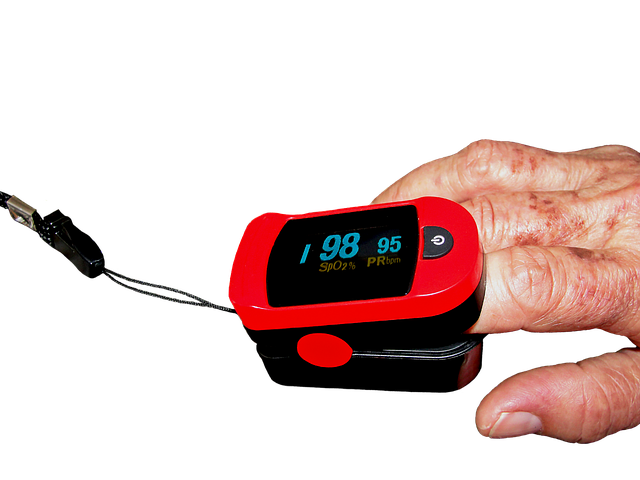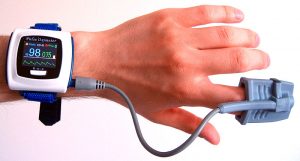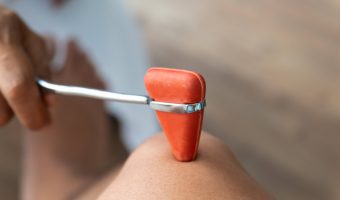Contents
- 1 What Is A Pulse Oximeter?
- 2 How To Select The Best Pulse Oximeter: Buying Guide
- 3 The 10 Best Pulse Oximeters: Reviews
- 3.1 1. Deluxe SM-110 Two Way Display Finger Pulse Oximeter
- 3.2 2. Acc U Rate Pro Series 500D Deluxe Fingertip Pulse Oximeter
- 3.3 3. Zacurate® Fingertip Pulse Oximeter
- 3.4 4. Zacurate Pro Series 500DL Fingertip Pulse Oximeter
- 3.5 5. AccuMed CMS-50DL Pulse Oximeter
- 3.6 6. Innovo Deluxe Fingertip Pulse Oximeter
- 3.7 7. Concord Emerald Fingertip Pulse Oximeter
- 3.8 8. Acc U Rate 430-DL Premium Fingertip Pulse Oximeter
- 3.9 9. FaceLake FL400 Pulse Oximeter
- 3.10 10. Concord BlackOx Fingertip Pulse Oximeter
- 4 Final Thoughts
For someone relatively inexperienced in the field of medical equipment, buying a device such as a pulse oximeter might get a bit too confusing, especially when there are so many options available on the market – and at a pretty decent price, as well.
See also:

So, how do you pick the best one?
If you don’t know where to start, you came to the right place – this best pulse oximeter buying guide will clear things up for you!
What Is A Pulse Oximeter?
 A pulse oximeter is a medical device intended for non-invasive measuring of oxygen levels (or oxygen saturation) in the arterial blood, as well as pulse rate. The main advantages they have over the more traditional testing methods are speed and cost – before pulse oximeters entered the market, the only accurate way to get a SpO2 reading was through a blood sample.
A pulse oximeter is a medical device intended for non-invasive measuring of oxygen levels (or oxygen saturation) in the arterial blood, as well as pulse rate. The main advantages they have over the more traditional testing methods are speed and cost – before pulse oximeters entered the market, the only accurate way to get a SpO2 reading was through a blood sample.
Being a non-invasive device that delivers results in a matter of seconds, and with an average accuracy rating of ±2%, a pulse oximeter is an excellent choice for essential on-the-spot readings – both for medical workers, as well as home use. All you need to do to get a reading and find out whether you have a normal oxygen level is to clip the device to the index finger.
How To Select The Best Pulse Oximeter: Buying Guide
Here are the critical factors to count in when you’re choosing the right pulse oximeter. Some of these might seem obvious to you but read through them carefully, nonetheless – they’ll take you one step closer to finding the best pulse oximeter for your needs.
Accuracy And Reliability
I thought it’s appropriate to start off with the most important thing to consider when buying any medical device or, in this particular case, a pulse oximeter – and what could be more important than making sure you’re getting a reliable and accurate device?
One way to ensure you’re buying a pulse oximeter that will provide reliable readings is to choose one that is manufactured by a well-known, reputable brand.
Display Size (Readability)
A pulse oximeter is a relatively small medical device, which means you should pay attention to the unit’s display size, as it will determine how easy it is to see the data shown on it. Speaking of data, it’s always nice to have large numbers and various ways of arranging data – a feature like this one will allow you to use the arrangement you find to be the most comfortable.
Another vital factor to consider regarding readability is how easy it is to see the numbers shown on display in different lighting conditions; you need to make sure you’re able to look at the data in broad daylight, as well as dark.
Battery Life
If you plan on using your pulse oximeter on a daily basis – and as a nurse, you probably will – getting a unit that can keep up is of utmost importance. That’s why battery life is one of the most important features to consider, besides the two already mentioned ones, of course.
You have two options here: either you’ll spend a bit more on a device that’s powered by lithium batteries (which are rechargeable in most cases), or you’ll get a cheaper one, that uses AAA batteries, in which case you want a minimum of 30 working hours.
FDA Approval
The United States Food and Drug Administration (commonly known by the abbreviation FDA) tests and ultimately approves a variety of items used for medical purposes – drugs and medical devices included. So, to put it clearly, when something is FDA approved,” it means that they recognize the benefits of the item’s planned use and confirm that these benefits outweigh any possible risks.
Since they are class II medical devices (43 percent of medical devices are), pulse oximeters need to be FDA approved to be sold and used in the United States. If you want to make sure the one you’re buying has, in fact, received approval by the FDA, you can check in their Medical Device Database – all you need to do is enter the manufacturer’s name.
Finger Size
 It goes without saying that a pulse oximeter you choose has to fit your finger; otherwise, you can expect some inaccurate reading – or, in a worst-case scenario, no reading at all. But how can you be sure you’ve picked the right one?
It goes without saying that a pulse oximeter you choose has to fit your finger; otherwise, you can expect some inaccurate reading – or, in a worst-case scenario, no reading at all. But how can you be sure you’ve picked the right one?
Here’s the thing: most newer models have an adjustable spring system that allows the pulse oximeter to accommodate a wide range of finger sizes – from children to adults. If you plan on sharing your pulse oximeters with several other family members, opt for an adjustable model.
But if your child is the one that needs a pulse oximeter, then you should certainly pick one explicitly made for pediatric purposes, because their sensors are correctly calibrated for the job.
Additional Features
Several different features don’t affect the accuracy and reliability of the pulse oximeter, but they certainly make it a lot more user-friendly. Also, if you’re stuck with a couple of models and can’t decide which one to buy, you can use these as a deciding factor.
Some of the most important additional features are:
● Automatic battery preservation mode (auto shut-off)
● History feature (easy access to previous readings)
● Audible alarms (help identify potential health concerns, like a drop in your normal oxygen level)
Price
Price definitely shouldn’t be one of the crucial factors – let alone a deciding one – when you’re buying a piece of medical equipment such as a pulse oximeter. On the other hand, that doesn’t mean you’ll have to spend hundreds of dollars on it, either – there are plenty of affordable options on the market, luckily for you.
The 10 Best Pulse Oximeters: Reviews
1. Deluxe SM-110 Two Way Display Finger Pulse Oximeter
Newly redesigned (significant improvements occurred in 2015), the SantaMedical’s Deluxe SM-110 Fingertip Pulse Oximeter is one of the most popular models currently available on the market. Because it’s able to provide highly accurate readings – SpO2 (blood oxygen saturation levels), pulse strength and rate – in a matter of seconds makes it an excellent choice for quick assessment of the patient’s status.Featuring a simple, one-button design and a large, bright LED screen, this pulse oximeter is an excellent example of a unit suitable for both home use and medical workers. The LCD brightness allows use in different lighting conditions, from broad daylight to dark surroundings. The display’s main advantage is the Two Way feature – you’re able to change the direction the results are shown in by nothing more than a touch of a button.
The device is powered by two AAA batteries and should be able to withstand up to 30 hours of ongoing use, due to the battery saver (or auto shut-off) feature; the addition of the low battery indicator only further improves the overall convenience.
Pros:
● FDA approved
● Affordable
● Easy to use
● Shows results in two directions
● Compact and lightweight
● Auto shut-off feature
● Large LED screen
● Suitable for a wide range of finger sizes
● Case and neck/wrist cord included
● Comes with two AAA batteries
Cons:
● Shows signs of wear and tear quickly
● Results won’t settle down for a proper reading
● The measurements disappear as soon as you take off the device
2. Acc U Rate Pro Series 500D Deluxe Fingertip Pulse Oximeter
Even though this model is designed mainly with sports enthusiasts in mind, the fact that it’s manufactured following FDA standards only goes to show that it could measure up to those pulse oximeters used by health professionals.One of the device’s most recognizable features is the auditory alarm – the device will notify you whenever your blood oxygen saturation level (SpO2) or pulse rate go beyond the previously set upper and lower range. Also, the oximeter will make a distinct beeping sound with every detected heart beat.
But that’s not all this Acc U Rate’s model has to offer. Looking at the OLED screen, you’ll notice something different – the plethysmograph waveform, which measures your pulse strength. On top of being able to adjust the screen brightness, you can also rotate it, but not just in two directions as the previously reviewed model – there are six different ways to display readings on this device. Not only do you change the screen’s orientation, but the arrangements of the data shown on it, as well.
Pros:
● FDA approved
● Relatively affordable
● Auditory alarm for out-of-the-usual readings
● Beeps for every detected pulse
● Rotatable display with six different positions
● Plethysmograph Waveform Technology measures pulse strength
● Adjustable screen brightness
● Comes with two AAA batteries
● A silicone cover and a lanyard included in the package
Cons:
● The alarm might be too quiet for some users
● Doesn’t show consistent sensitivity
● It might be too big for children
3. Zacurate® Fingertip Pulse Oximeter
With the ±2% accuracy when it comes to determining the blood oxygen saturation level (or SpO2) and the FDA’s seal of approval, it’s pretty clear that this is a pulse oximeter made with the idea of meeting the high standard for devices used by health professionals.However, it is mainly designed to be used privately – with sports enthusiasts and pilots in mind. That becomes somewhat clear with just one look at the display – the results shown on it are facing the user, and there’s no way to rotate the screen, which is a minor inconvenience when compared to some other models on the list. You’ll get accurate readings in about ten seconds – SpO2 and pulse rate are shown on the unit’s large display.
Now, let’s talk power – the pulse oximeter runs on two AAA batteries (which come included in the package), and they should be able to provide up to 600 uses. To make things more convenient for you, the battery level indicator is also shown on the screen, and the automatic shut-off will act as a built-in battery saver.
With all this in mind, it’s interesting to see that this Zacurate’s pulse oximeter remains surprisingly affordable.
Pros:
● FDA approved
● Extremely affordable
● Easy to use with clear instructions
● The reading only takes 10 seconds
● The display faces the user
● Long battery life (up to 600 uses)
● Shuts down automatically
● Compact and easy to carry
● The package includes two AAA batteries and a lanyard
Cons:
● You can’t rotate the screen
● Doesn’t come with a protective case
4. Zacurate Pro Series 500DL Fingertip Pulse Oximeter
Okay, now it’s time to get serious – the Zacurate’s Pro series lives up to its name. The concept behind the 500DL was to improve everything that was wrong – according to over 2000 customers – with the CMS 50DL series.Did they manage to fix it?
They most certainly did – in about 10 seconds, you’ll get an accurate (±2% accuracy rate) reading of your SpO2, pulse rate, as well as pulse strength. One of the main improvements is the fact that it’s no longer sensitive to indoor lightning – the Pro series shows no signs of deviation when measuring oxyhemoglobin values. One thing that didn’t change, though, is the fact that these are also made according to the FDA’s standards, which means they meet the criteria for pulse oximeters used by health professionals.
Powered by two AAA batteries (they come with the device), the device should be able to give you a good 40 hours of continuous use out of a single pair. While there’s no audible low battery alert, you can still see the battery level indicator on the screen.
Pros:
● FDA approved
● Relatively affordable
● Easy to use and comfortable (no pinching)
● Suitable for kids, as well as adults
● You can see the readings even in low light conditions
● Takes a reading in just 10 seconds
● 40-hour battery life
● Comes with a protective silicone cover and a lanyard
● Two AAA batteries included
● Excellent customer service
Cons:
● No audible low battery alert
5. AccuMed CMS-50DL Pulse Oximeter
Overall, the AccuMed CMS-50DL is an okay pulse oximeter. Featuring a simple, one-button design, a large display, and a sensor that accommodates most finger sizes (from pediatric to adult), this is a useful model to have at hand when you need to check your SpO2 and pulse rate. The question is: is it excellent?No, not really; you get what you paid for with this one.
Power-wise, there are two things worth mentioning; first off, the device has the auto shut-off feature, which sets in five seconds after you stop using the unit. On top of that, the LED display has low power consumption. When combined, these features give you up to 40 hours of continuous use.
However, keep one thing in mind – I couldn’t find the info on whether or not the product is FDA approved, so if that’s something you’re after, keep looking. This is a unit made for personal use only, and it’s in no way meant to be used by medical professionals – that goes without saying.
Pros:
● Affordable
● 40-hour long battery life
● Suitable for adults, as well as pediatric use
● It’s accurate and easy to use
● Auto shut-off feature takes only five seconds to set in
● Comes with two AAA batteries, a carrying case, and a lanyard
Cons:
● No info about it being FDA approved
● The case falls off easily
● Sometimes you need to re-take readings several times
● Can’t change screen directions
6. Innovo Deluxe Fingertip Pulse Oximeter
I love a unit that stands behind its name, and this Innovo Deluxe pulse oximeter is one of those devices – it truly measures up to the „Deluxe” part in its name.Here’s what makes it stand out: there’s no more guessing if you’re using the device correctly or not. In case you don’t measure your SpO2 and pulse rate the way you should, you’ll get notified about it so that you can make the necessary adjustments. The device includes a Plethysmograph, as well as the Perfusion Index (PI), which makes it one of the most advanced pulse oximeters on the market, as far as sensitivity and accuracy go.
To make it easier to keep track of your stats, you can set the upper and lower limits of your SpO2 and pulse rate. That way, the device will notify you via an auditory alarm if the results are outside the normal oxygen level.
You’ll see the results on a large, multi-directional display with six different layout options to choose from, depending on whether you’re using the device on yourself or someone else.
Pros:
● Plethysmograph and Perfusion Index (PI) help you get an accurate reading every time
● Audible alarm will notify you of unusual results
● The screen is large and multi-directional (six different layouts)
● Beeps for every detected pulse
● Adjustable brightness
● Shuts down automatically
● Compact and lightweight
● Easy to use
● Comes with two AAA batteries and a lanyard
Cons:
● It’s a bit more expensive
● Battery life seems to be too short
7. Concord Emerald Fingertip Pulse Oximeter
Concord is a well-known brand when it comes to health supplies, so it shouldn’t come as a surprise when I tell you that their Emerald series of pulse oximeters falls into the category of the most popular models on the market.Affordable price and the user-friendly one-button concept paired with a bright two-way LED screen (usable in both dark and daylight) is what makes this the number one choice of so many sports enthusiasts and those interested in tracking their SpO2 and pulse rate due to health conditions.
But here’s what’s unique about it: it comes in several different colors; while this is by no means a deciding factor, it’s nice to know that you can choose the one you like.
The unit comes with two AAA batteries that should provide a good 30 hours of use; the best thing is you don’t have to worry about shutting the device off – the auto shut-off feature sets in eight seconds after you remove your finger from the sensor. The device is equipped with a low battery indicator, to make sure you never run out of power at an inconvenient time.
Pros:
● Several color options to choose from
● Relatively affordable
● The auto shut-off feature kicks in 8 seconds after you remove it from your finger
● Suitable for adults and kids (7 years and up)
● Two-way rotating, bright red, LED screen
● Low battery indicator
● Two AAA batteries included
● Carrying case, shock-resistant protective cover, and a neck/wrist lanyard included in the package
Cons:
● It’s a bit harder to get a reading when used on kids
8. Acc U Rate 430-DL Premium Fingertip Pulse Oximeter
I like how the Acc U Rate continues to make pulse oximeters for sports enthusiasts (bikers, mountain climbers and the like), but they continue to meet the FDA standard for pulse oximeters used by medical professionals. And not only do they fit those criteria – the 430-DL series exceeds them.Here’s the deal with the 430-DL: while the FDA requires a ±2% accuracy when measuring SpO2, this model exceeds those requirements and sets a new record with its ±1% deviation – under lab conditions, that is. So, if you’re looking for a supreme level of accuracy, this one’s the best choice for you.
The plethysmograph waveform, which helps you visualize your heartbeat, also enables you to determine the best time to take a reading. The results are shown on a large, multi-directional screen (being able to display the results in six different ways seems to be the standard for Acc U Rate’s models) with an adjustable brightness level, which makes it easy to read in a wide range of lighting conditions.
Pros:
● FDA approved
● The plethysmograph waveform provides a visual representation of your heartbeat
● Adjustable brightness level
● Large OLED screen
● Multi-directional display (six different layouts)
● Suitable for a wide range of finger sizes
● Packaging includes two AAA batteries
● Comes with a silicone cover and a lanyard
Cons:
● Costs a bit more than most models on this list
● It may be hard to read in direct sunlight
9. FaceLake FL400 Pulse Oximeter
Even though all of the pulse oximeters I reviewed today are relatively affordable (some more than the others), this one pretty much takes the cake affordability-wise. Now, let’s see what you get for the price.Again, we have a device made to fit the FDA’s strict standards; the result is the fast, yet accurate pulse oximeter suitable for both kids and grown-ups. And when I say fast, I do mean it – you’ll have your readings up on the screen in just 10 seconds.
Speaking of the screen, while it is somewhat vibrant, it doesn’t allow you to change the direction of the display, which I realize is a minor inconvenience, but I felt like it was worth mentioning, nonetheless.
Besides the SpO2 and pulse rate, you’ll find two more icons on the LED screen – the heart rate bar graph and the low battery indicator. The latter is combined with an automatic shut-off feature, so you can count on your pulse oximeter when you need it the most.
Pros:
● FDA approved
● Extremely affordable
● Large LED screen for straightforward reading of the results
● Takes a reading in about 10 seconds (or less)
● Automatic shut-off feature
● Low battery indicator
● Two AAA batteries included
● Comes with a nylon carrying case and a neck lanyard
Cons:
● You can’t change the display’s direction
● Difficult to read on your own
● The battery cover seems to break easily
10. Concord BlackOx Fingertip Pulse Oximeter
The best way to describe the Concord’s BlackOx model would be: quick, accurate, and easy to use. If you take a look at its basic (and I mean that in the best way possible) single-button design, large display, and the sensor suitable for pretty much everyone – kids over seven years of age and adults – you’ll soon realize why I said that.As you can probably guess, the unit is powered by two AAA batteries; again, these come with the device so that you can use it right out of the box. When combined with the excellent auto shut-off feature, which acts as a power saver and kicks in eight seconds after you take the pulse oximeter off, you can probably get more than 30 hours of use out of a single set of batteries. Once you get low on power, the indicator (located on the screen) will notify you about it.
Speaking of the screen, I’d like to add it’s clear that it was made with user convenience in mind. Not only is the brightness fully adjustable, but the screen can be rotated in two ways, as well, to fit your needs depending on whether you’re a caregiver or using the device on yourself.
Pros:
● Reasonably priced
● Dual color digital OLED screen
● Two-way orientation of the display
● Adjustable brightness
● Auto shut-off sets in after 8 seconds
● Two AAA batteries included
● Silicone protective cover, a carrying case, and a lanyard included in the package
● Comes in a custom, foam-padded box, which is reusable
Cons:
● It’s hard to see the readings in direct sunlight
● Sometimes it has a hard time taking a reading (in less-than-perfect conditions)
● Not FDA approved
Final Thoughts
If you ask us here at the Things Nurses Like, the definitive winner of the round-up is the Innovo Deluxe Fingertip Pulse Oximeter.
Remember that price isn’t everything, but with these, you tend to get what you paid for, so choose carefully – getting an FDA approved device is probably the best way to make sure you’re getting your money’s worth.
I hope you found these reviews helpful and that you’re now a step closer to finding the best pulse oximeter for your needs. Last but not least, not only your oxygen level but also the condition of heart and lungs and other stats that you need to keep track of. Get information about medical diagnostic equipment which will support you on our site as well.















Leave a Reply